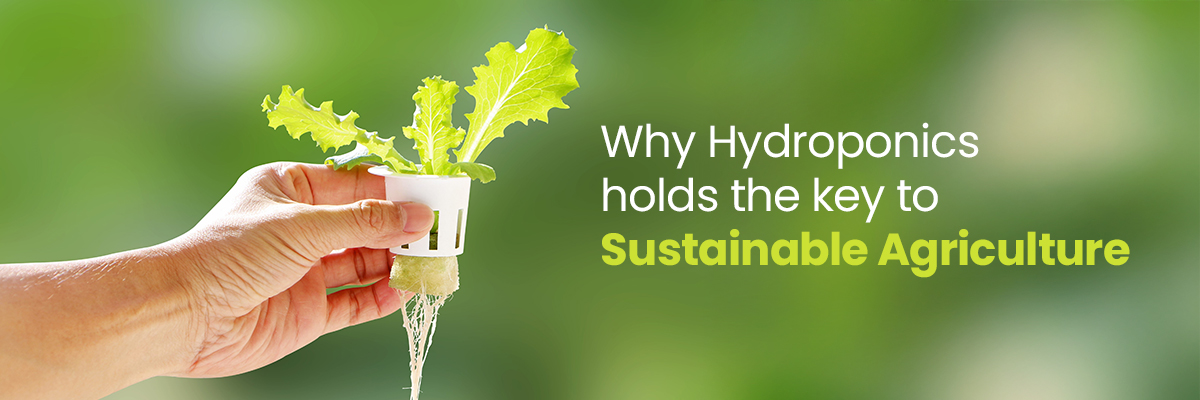A variety of plants, especially three species of philodendrons, have long been thriving at my home. Surprisingly, with my vast and wide experience with pet fish, soil is not the source of the manure to these plants but recycled water that’s home to African cichlids.
Yes, rice-fish farming is a century-old agricultural practice in China. But this technique of raising fish and house plants in a fish tank—the home to the cichlids—can be categorised as aquaponics or a more modern technique of aqua scaping clubbed with terrarium.
Another closely related technique to this is hydroponics!
From organic produces to thriving businesses just on a rooftop or indoors has become very popular in India and the hydroponics market here that reached $1.4 billion in 2022 has been forecast to reach $5.3 billion by 2031, growing at a CAGR of 17.6%.
Among drivers behind this growth include rapid urbanisation and shrinking agricultural land, water scarcity and the need for water-efficient farming methods, increasing demand for organic and pesticide-free produce and supportive government initiatives promoting agri-tech innovations.
This article explores the details of hydroponics, what are the related technologies and practices that can be combined with this method to make the most of it and what it has for investors domestically and globally.
Not to miss out: the challenges and risks attached to this new-age gardening and farming method!
So, what’s hydroponics?
Hydroponics is a method of growing plants without soil, utilising mineral nutrient solutions in an aqueous solvent. This technique allows for precise control over plant nutrition and can lead to faster growth rates and higher yields compared to traditional soil-based cultivation.
The global hydroponics market has experienced significant growth in recent years. In terms of revenue, it was estimated to be worth $12.1 billion in 2022 and is poised to reach $25.1 billion by 2027, growing at a CAGR of 15.6% from 2022 to 2027.
Market segmentation
In India, hydroponics is gaining traction as a sustainable and efficient agricultural practice, especially in urban and peri-urban areas where water and land scarcity exists, and the market is divided into three primary segments:
- Commercial hydroponics that holds 60% of the market share, growing at 22% annually
- Residential/urban farming that accounts for 25% of the market, with an 18% annual growth rate and
- Research and educational purposes that represent 15% of the market, growing at 15% annually
As investor interest in hydroponics has been increasing steadily, let’s look at the recent investments in this sector before moving into detail on what technologies work best with hydroponics, the challenges, of course, but how the government has been supportive of this.
Several key players are driving innovation in the Indian hydroponics market and among notable recent investments include:
- UrbanKissan: Focuses on vertical hydroponics at a large scale in Bengaluru and raised $3 million from Kalari Capital in 2022
- Clover: Specialises in IoT-enabled hydroponics at a large scale in Hyderabad and secured $5.5 million from Accel and Omnivore in 2021
- Future Farms: Operates commercial hydroponics on a large scale in Chennai and attracted $2 million from HNIs and family offices in 2023
But there are challenges and risks associated with these techniques and despite its immense potential, the hydroponics market faces several challenges like high initial setup costs, limited awareness among traditional farmers, uncertain regulatory frameworks and scalability concerns for small farmers.
However, with training and skill development of farmers and aspirants, investment opportunities in this sector can’t be missed out with being mentioned. Hydroponics presents a range of investment opportunities, including:
- Urban hydroponic farms: Catering to the demand for locally produced, pesticide-free vegetables
- Community hydroponics projects: Promoting cooperative farming in urban areas and
- Export-oriented hydroponics: High-value crops like herbs and exotic vegetables
Government support
The Indian government is playing a pivotal role in fostering the hydroponics ecosystem through several initiatives:
- PM-KUSUM Scheme: Promoting solar-powered hydroponic farms
- Agri-Infra Fund: A ₹1 lakh crore fund supporting agri-tech infrastructure
- StartUp India: Offering financial and incubation support for Agri-tech startups
“Hydroponics is more than just an innovative farming technique; it is the foundation of sustainable agriculture in an era of urbanisation and resource constraints. By harnessing cutting-edge technology, strategic investments and strong government support, we have a remarkable opportunity to redefine organic food production, making it more efficient, resilient and accessible along with the produce being pesticide-free. As we navigate the challenges of limited land, water scarcity and rising food demand, hydroponics emerges as the key to a high-efficiency, future-ready farming system that can nourish generations to come,” says Gaurav Sishodia, Vice President, Agri-Food sector at Invest India.
Besides solar-powered hydroponics promoting sustainable and off-grid farming solutions and supported by the government, hydroponics systems are becoming increasingly sophisticated and innovative and here integration of emerging technologies has become pivotal.
Technology integration
- IoT (Internet of Things) and smart sensors
How it integrates: IoT devices monitor and control water levels, pH, temperature, light intensity and nutrient concentration in real time.
Benefits: Automated nutrient delivery, optimised resource usage and early detection of plant health issues.
Example: Smart hydroponics kits like Aerospring Hydroponics or CropX integrate IoT for remote monitoring. - Artificial Intelligence (AI) and Machine Learning (ML)
How it integrates: AI algorithms analyse data from sensors to optimise nutrient cycles, predict plant growth patterns and detect diseases.
Benefits: Automated decision-making, yield forecasting and precise control over resource usage.
Example: GroLab uses AI-based systems to automate and optimise hydroponic operations. - Blockchain
How it integrates: Blockchain can be used to track the entire lifecycle of crops from seed to harvest.
Benefits: Transparency in the supply chain, ensuring quality standards and eliminating middlemen.
Example: Startups like AgriLedger provide blockchain-based solutions for farm-to-fork transparency. - Aeroponics
How it integrates: A combination of hydroponics and aeroponics (where roots are suspended in the air and sprayed with nutrient solutions).
Benefits: Higher oxygen exposure, faster growth rates and reduced water usage.
Example: NASA’s Viking Experiment pioneered aeroponics for growing crops in space. - Aquaponics
How it integrates: Merges hydroponics with fish farming. Fish waste provides natural nutrients for plants and plants clean the water for fish.
Benefits: Self-sustaining ecosystem, zero chemical fertilisers and high water efficiency.
Example: WaterFarmers Aquaponics in India uses this technique for sustainable farming. - Vertical farming systems
How it integrates: Hydroponics can be combined with multi-tiered racks in vertical farms, especially in urban areas.
Benefits: Space efficiency, reduced water consumption and year-round production.
Example: Companies like AeroFarms and UrbanKissan are already using this model in India. - Solar-powered hydroponics
How it integrates: Solar panels power the entire hydroponic system, including water pumps and lighting.
Benefits: Reduced operational costs, sustainability and off-grid farming.
Example: Projects like Solar Hydroponic farms in Rajasthan have been deployed for desert agriculture. - Automation and robotics
How it integrates: Robotics automate tasks like planting, harvesting and nutrient delivery.
Benefits: Reduces labour costs, increases precision and ensures consistent quality.
Example: Iron Ox uses autonomous robots for hydroponic farming in the US. - LED-based smart lighting systems
How it integrates: LED lights with customisable wavelengths optimise plant growth without natural sunlight.
Benefits: Faster plant growth, energy efficiency and reduced carbon footprint.
Example: Philips GreenPower LED systems are widely used in hydroponics. - Data Analytics platforms
How it integrates: Data from IoT sensors, weather forecasts and plant growth patterns is analysed to optimise crop yield.
Benefits: Predictive farming, better resource management and higher yields.
Example: Agrivi offers cloud-based farm management solutions integrating hydroponic systems.
“Hydroponics is revolutionising agriculture in India with a market poised to reach $325 million by 2030 from $75 million in 2023—growing at a 20%+ CAGR. This innovative method, backed by initiatives like the PM-KUSUM Scheme, Agri-Infra Fund and StartUp India, is gaining traction wherein it's simultaneously with time integrating cutting-edge technologies such as IoT, AI, blockchain and solar-powered systems to enhance efficiency and sustainability.
“Despite challenges like high setup costs, limited awareness and scalability concerns, investment opportunities abound in urban farms, tech-driven ventures, community projects and export-oriented hydroponics. Hydroponics is set to redefine the future of sustainable agriculture in India with key players like UrbanKissan, Clover, WaterFarmers and Future Farms leading the charge already,” says Sujatha UG, Vice President, Global Partnerships and Net Zero at Invest India.
What the future holds
Hydroponics, combined with these technologies, forms the backbone of Agriculture 4.0 , making it a key player in urban farming, climate-resilient agriculture and food security.
As climate change accelerates, hydroponics is expected to grow at a CAGR of 18-20% globally by 2030 and become a cornerstone of sustainable agriculture not only globally but in India.
Investors can leverage this momentum by supporting early-stage startups, partnering with government-backed agri-tech programmes and exploring urban-centric hydroponic projects.
This blog is written by Jaydeep Saha
- https://www.linkedin.com/posts/jaydeepsaha1203_sustainability-sustainablepractices-technology-activity-7112796253058400256-6xSq
- https://library.enaca.org/AquacultureAsia/Articles/Oct-Dec-2003/13ricefishfang.pdf
- https://www.datamintelligence.com/research-report/india-hydroponics-market
- https://www.marketsandmarkets.com/Market-Reports/hydroponic-market-94055021.html
- https://www.marketsandmarkets.com/Market-Reports/hydroponic-market-94055021.html
- https://www.agritechtomorrow.com/story/2024/08/vertical-farming-technology-market-set-for-25-cagr-growth-by-2030/15792/
- https://pmc.ncbi.nlm.nih.gov/articles/PMC10625363/
- https://www.urbankisaan.com/
- https://www.forbesindia.com/article/how-we-survived/clover-uprooted-to-deep-rooted/67291/1
- https://www.business.futurefarms.in/
- https://pmkusum.mnre.gov.in/#/landing
- https://agriinfra.dac.gov.in/
- https://www.startupindia.gov.in/
- https://agriledger.com/
- https://www.nasa.gov/exploration-research-and-technology/growing-plants-in-space/
- https://waterfarmers.com/
- https://www.aerofarms.com/
- https://www.urbankisaan.com/
- https://kryzen.com/hydroponic-farm-set-up-in-rajasthan/
- https://www.ironoxfarming.com/
- https://www.lighting.philips.com/application-areas/specialist-applications/horticulture/greenpower-specialist-applications
- https://www.agrivi.com/
- https://www.researchgate.net/publication/355988707_Digital_Transformation_for_Sustainable_Future_-_Agriculture_40_A_review

